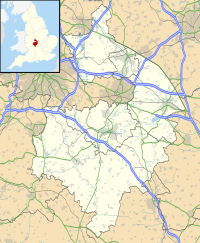
Back قلعة كينيلورث Arabic Кенилуърт (замък) Bulgarian Kenilworth Castle CEB Kenilworth Castle Danish Kenilworth Castle German Kastelo Kenilworth Esperanto قلعه کنیلوورث Persian Château de Kenilworth French טירת קנילוורת' HE Kastil Kenilworth ID
| Kenilworth Castle | |
|---|---|
| Warwickshire, England | |
 Kenilworth Castle, viewed from the site entrance | |
 Shown within Warwickshire | |
| Coordinates | 52°20′53″N 1°35′32″W / 52.3479693°N 1.5923611°W |
| Grid reference | grid reference SP2794172163 |
| Type | Inner and outer bailey walls with great tower |
| Site information | |
| Owner | Town of Kenilworth |
| Controlled by | English Heritage |
| Open to the public | Yes |
| Condition | Ruined |
| Site history | |
| Materials | New red sandstone |
| Battles/wars | Siege of Kenilworth (great siege of 1266) |
Kenilworth Castle is a castle in the town of Kenilworth in Warwickshire, England, managed by English Heritage; much of it is in ruins. The castle was founded after the Norman Conquest of 1066; with development through to the Tudor period. It has been described by the architectural historian Anthony Emery as "the finest surviving example of a semi-royal palace of the later middle ages, significant for its scale, form and quality of workmanship".[1]
Kenilworth played an important historical role: it was the subject of the six-month-long siege of Kenilworth in 1266, thought to be the longest siege in Medieval English history, and formed a base for Lancastrian operations in the Wars of the Roses. Kenilworth was the scene of the removal of Edward II from the English throne, the perceived French insult to Henry V in 1414 of a gift of tennis balls (said by John Strecche to have prompted the campaign that led to the Battle of Agincourt), and the Earl of Leicester's lavish reception of Elizabeth I in 1575. It has been described as "one of two major castles in Britain which may be classified as water-castles or lake-fortresses...".[2]
The castle was built over several centuries. Founded in the 1120s around a powerful Norman great tower, the castle was significantly enlarged by King John at the beginning of the 13th century. Huge water defences were created by damming the local streams, and the resulting fortifications proved able to withstand assaults by land and water in 1266. John of Gaunt spent lavishly in the late 14th century, turning the medieval castle into a palace fortress designed in the latest perpendicular style. The Earl of Leicester then expanded the castle during his tenure in the 16th century, constructing new Tudor buildings and exploiting the medieval heritage of Kenilworth to produce a fashionable Renaissance palace.
